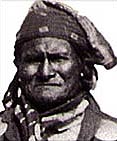Apache Indian (Goyathlay –1829-1909)

To other members of the Chiricahua (chair-i-cow-ah) Apache, Geronimo seemed to reflect all things they embraced as a people – courage, diligence and aggressiveness – qualities that for years kept them relatively safe from the increasing white encroachment in Arizona and New Mexico.
The Chircahuas were nomadic, following game and farming in the warmer months. But when times were tough and food was scarce raids on other tribes was the way of life, and considered honorable.
Geronimo was born Goyathlay (One Who Yawns) in Arizona, grandson of a chief of the Nedni Apache, but his father married a Bedonkohe Apache and joined her tribe, thereby forfeiting his hereditary right as leader. Therefore, contrary to popular ideas, Geronimo was never a chief. He was a dutiful follower of many great chiefs though, including Cochise and Coloradas.
While many Europeans were trickling into the area, the Spanish were already firmly in place for years. The whites were a problem, but it was Mexican soldiers who raided and killed Geronimo’s family – his mother, wife and three children. Prior to this event, Geronimo had been considered more a holy man than a warrior, but as a result of his loss he often spoke of his hatred for whites and coveted a vengeance that would bring him to kill as many as he could.
Geronimo’s “white name” came as a result of his fearless and resourceful as a warrior. While leading a charge against Mexicans they began to shout “Geronimo!” seeking help from their patron saint, Jerome, or Geronimo in Spanish. Emerging conqueror over the Mexicans, the warriors bestowed the name of Geronimo on their fearless leader. To this day the name remains a battle cry.
The army tried to place all the Chiricahua on reservation in 1876, but Geronimo fled to Mexico and escaped capture for a decade. While the press is accused of “making news” these days, so it was then. The press had Geronimo everywhere and doing everything, often at the same time.
The media image of Geronimo made him the most high-profile and feared of all the Apache. It wasn’t all myth however. His name was associated with terror in the Southwest and ultimately it took more than 5,000 soldiers and 500 scouts to track down Geronimo and his followers.
He finally surrendered after hearing his people were being sent East. He was the very last renegade Indian to surrender to white authority. Geronimo was sent to a reservation in Florida for two years, where many died of malaria or tuberculosis. Geronimo longed to return to his beloved Arizona, but that was not to be so. He was to make another stop in Alabama before finally being placed on a reservation in Oklahoma, which at least bore a climate more similar to that of the Southwest. It was here, at Fort Sill, that he spent the last 14 years of his life.
In his old age, Geronimo learned a little English and how to write his name. He became very enterprising in his ability to market himself and his legacy, selling buttons from his coat for a quarter apiece, his hat for five dollars or bows and arrows that he made. For 50 cents, he would sign his name. If asked he would show off his battle wounds with pride. He also made personal appearances at places like Oklahoma fairs, the Exposition in Omaha in 1898, the Pan-American Exposition in Buffalo in 1901, the St. Louis World’s Fair in 1904 and Teddy Roosevelt’s inaugural parade in 1905.
Despite making the rounds as an “attraction,” Geronimo was never allowed to return to Arizona. As an old man, he remained a crack shot, and he enjoyed good health well into his 80s. Geronimo also drank, sometimes to excess and this ultimately was his demise. On a cold night in February of 1909, drunk, he fell off his horse and lay undiscovered on the cold ground. This brought on pneumonia and he died a few days later.





